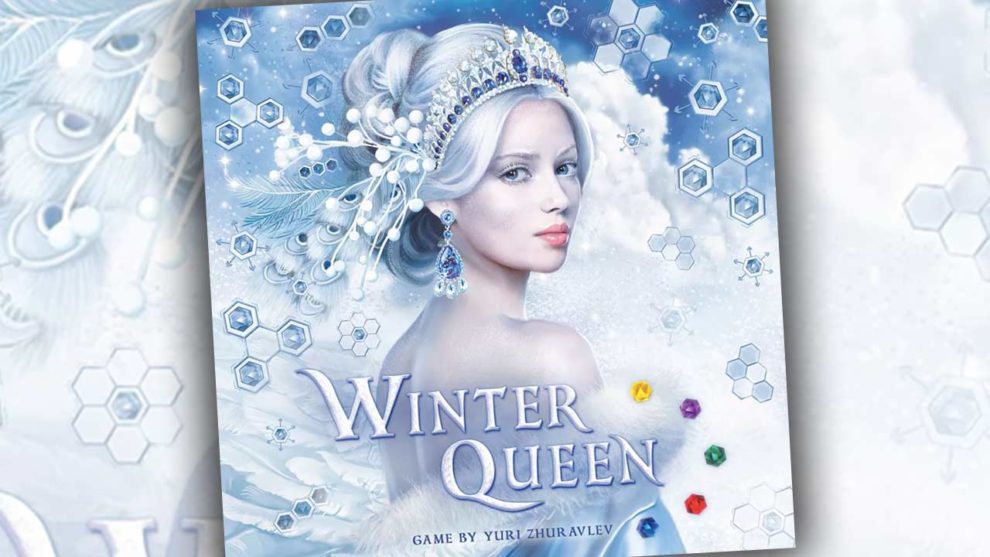Disclosure: Meeple Mountain received a free copy of this product in exchange for an honest, unbiased review. This review is not intended to be an endorsement.
Imagine the world of Frozen, the one where Elsa set off an eternal winter. Now imagine everyone was actually OK with that because the queen was a bit more accessible and oh-so-kind (yes, I know, Elsa is a work in progress, it’s a joke). There you have the setting for Winter Queen, an abstract gem-laying game from designer Yuri Zhuravlev and CrowD Games. As the story goes, players take up the role of wizards competing to become the queen’s key advisor. As the game goes, however, there is no story of consequence; but that’s OK.
The board for this puzzle is a grid of 25 hexagons arranged into four regions of five spaces plus five isolated spaces—a hexagon of hexagons. Each of the four regions has a color and a corresponding stack of spell book tokens just off the board. A round tile between each of the players, a crested plate of sorts, holds crystals drawn from a bag.
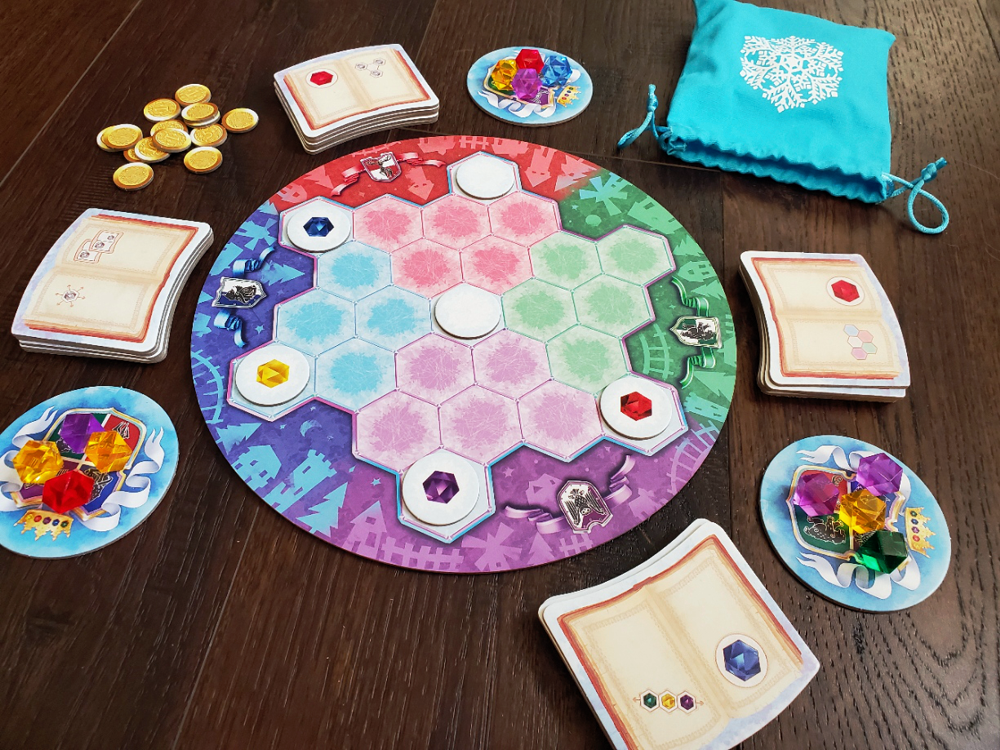
Each player’s turn comes with a choice of three actions. The first is placing a crystal anywhere on the board, taking the top spell book token from the corresponding stack if desired. The second is placing a crystal on a previously claimed spell book (each of which has two visible pages) as a declaration of the player’s intent to create a certain pattern on the board. The third is scoring a spell book according to the declared pattern.
Depending on the player count, some of the fineries shift around, like the number of available crystals on each plate and which plates may be drawn from. But in each iteration, any player who draws the final crystal from the plate gains 1VP token and refills.
The spell books contain eight different patterns. The idea is that the chosen crystal becomes the focal point of the pattern. 1VP for each region containing that color. 1VP for each empty space around a gem of that color. 1VP for each matching gem around the outside edge. Or pairing the crystal with a gem printed on the page and seeking out the cluster where one is most surrounded by the other. When a book scores, the player simply points out the location of the pattern for one or both pages and claims the VP tokens.
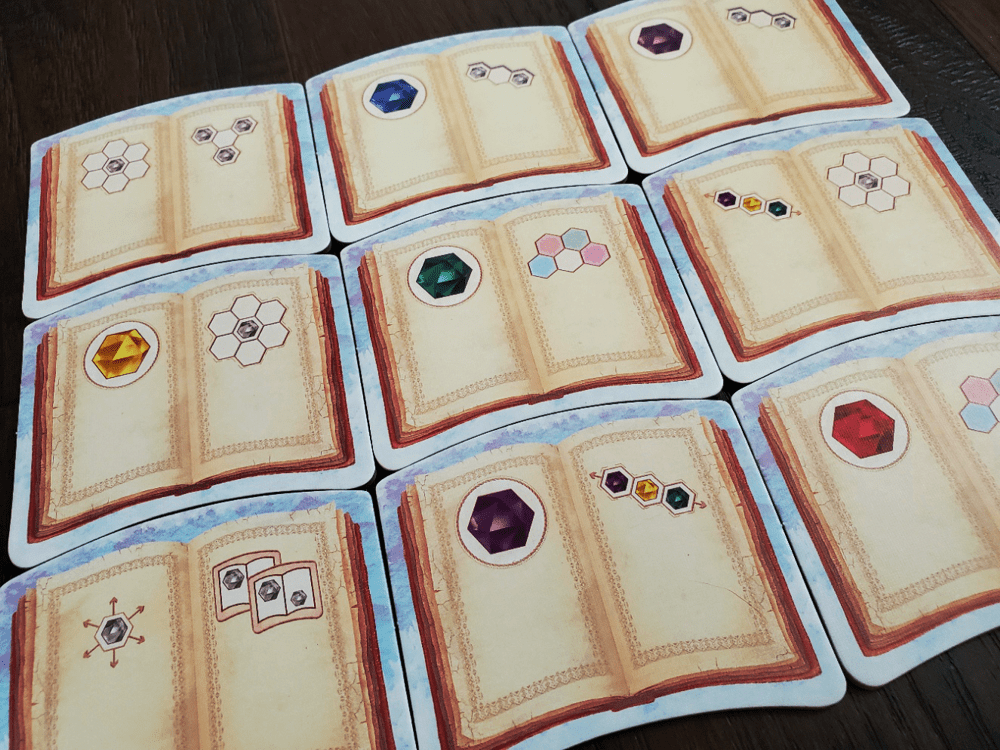
When a book is scored containing two gems, the action is followed by removing one gem from the board, either setting up a future move, messing with someone else’s life, or, ideally, both.
The game continues in this fashion until the final gem sees daylight. At that point all of the gems are combined, the current round is finished, one additional round is played (mostly to lay a final gem on a page in a shameless point grab) and the game ends. Every open book is scored and the points tallied to find a winner. Easy peasy.
Oh, so these are the frozen fractals she was singing about!
The first play of Winter Queen is exceptionally awkward. There are 25 spaces on the board, up to five of which might be covered during setup by randomized gem tokens. There are 45/40/30 gems in the game at 4/3/2 players, respectively. Plus, 16/12/9 of those gems are already out of the bag to start the game. There’s not a lot of room for action before this thing is over, because the shiny bits disappear pretty quickly.
If there is brilliance in the design, and I’m not comfortable with that statement yet, this claustrophobia is where it begins. Every breath matters. Placing a gem on the board is constrictive because you’re occupying 1/25th of the total space, servicing your own desires, preferably hindering those of the opposition, all while potentially making a selection based on a book whose patterns interest you. Placing a gem on a spell book is easy yet doubly constrictive because not only are you taking a turn not creating the pattern, you are removing from the game one of the gems potentially needed to create the pattern. Did I mention there are only 9/8/6 of each gem in the game depending on the player count?
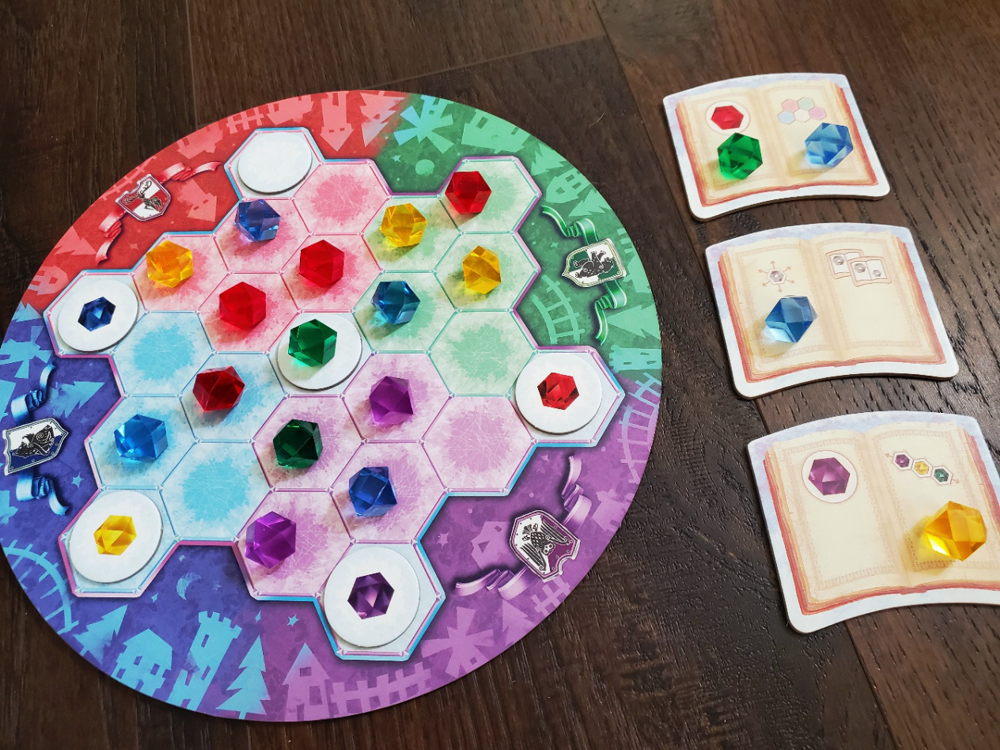
There is an added pressure to complete both patterns in each book because removing a gem is a big deal in a game this tight. Everyone’s work is visible. Players can hold up to three books, so there are a lot of intentions laid bare on the table when the time comes to erase a piece of somebody’s plans. Gem counting is a real occupation in the Queendom, my friends!
I have two major issues with the components. First, I cannot fathom the reason behind printing every cardboard coin in the same color and size, and failing to print the number on both sides?! They are small and they are hard to read even when they’re right side up. This was a sizable miss because collecting the coins is the object of the game. And speaking of size, the box size is utterly wasteful, and all in the name of the round central board. A single-fold board or a series of region pieces that slide together would have allowed for a box half the size (or less). Games like Winter Queen have a greater chance of staying in the collection when they take up less space on the shelf.
Otherwise, I like the big chunky gems and their bag; and the spell books are solid, reminiscent in quality of the books in Quacks of Quedlinburg. The board is two-sided to provide an aesthetic alternative with no functional difference—excessive, but a nice touch. As the game progresses, it really is quite pretty on the table.
The iconography is simple enough. It’s only mildly overwhelming to learn eight patterns at the beginning of the game, not unlike the struggle at the outset of SiliconVania, another puzzle that sings a finer tune once you’re firmly through the front door. Everything makes sense in a relatively short period of time, which is good because then the claustrophobia can set in.
The theme is what it is, but Winter Queen is a straight abstract. The box cover (Scarlett Johansson?) is nice, but if not for the fact that the books are books, the whole wizard thing would be lost and forgotten by the second turn.
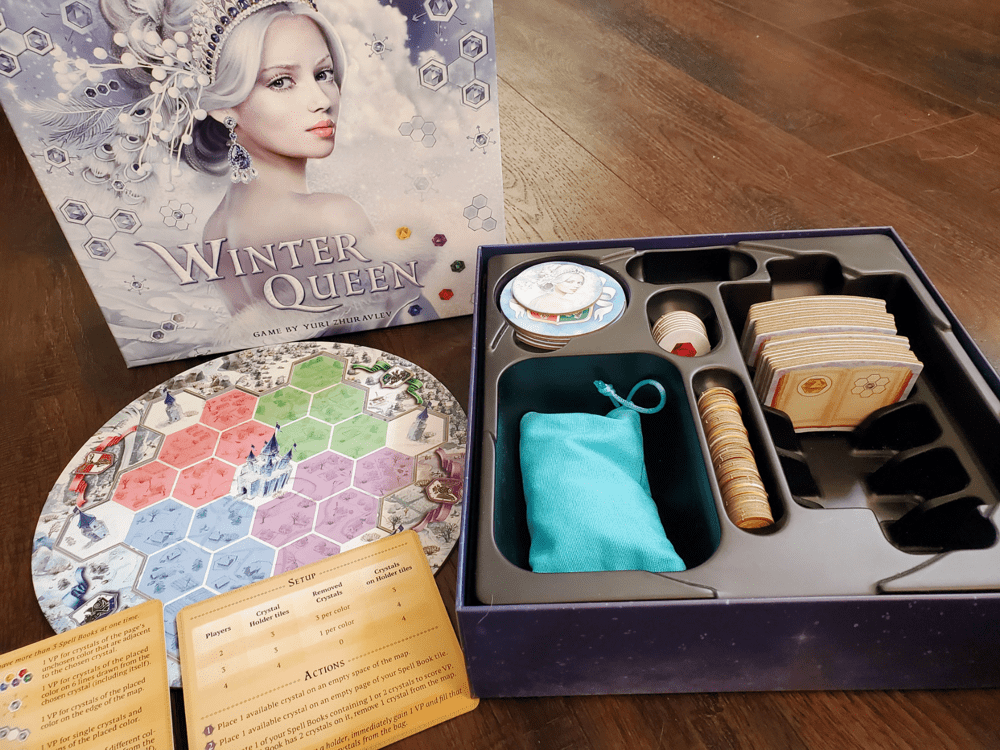
What’s left behind is an interesting puzzle. Kids can play, there’s no doubt. Our five-year-old understands her three options, even if she’s laser focused on a single pattern at a time. Our ten-year-old makes a few more strategic decisions with multiple open books. But this one works well with a table of adults and teens who want to give a half hour to the subtle mind games. I’m not sure the awkwardness has gone away yet. I’m not sure if it will at all. But I know what I’m getting into now, and I’m finding more to enjoy in the close quarters.
We definitely enjoyed the experience more with each increase in the player count. I prefer the added restriction at three and four players in which players can only claim crystals from the plates to their left and right. I also like the mishmash of desires in steady conflict at four players.
The five single spaces that receive tokens during setup ensure a hint of built-in variability in the board. There is also a set of mini-expansions in the aether, spoils from the Kickstarter campaign. Gratitudes adds a set of single-use abilities for each player that allows for more mobility with the gems. Royal Jewelry adds a side board to which players dump their spent jewels, building up like a pyramid. These spent jewels then provide bonus points for the end of the game. I can definitely see the appeal in loosening the ropes and making use of spent gems. There is also a solo mode called The Great Wizard.
If you’re looking for a highly thematic Frozen-style family adventure game, this is not your title. But if you’re looking for an abstract that forbids you to have cake and eat it too—while vaguely dressed in the garb of a glittery dreamscape—Winter Queen just might be for you.


